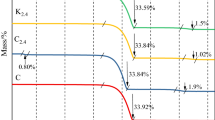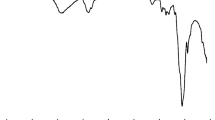Abstract
Tricalcium aluminate (C3A) and tricalcium silicate (C3S) with gypsums play an important role in the hydration of oil well cement. This study aims to assess the influence of C3S and C3A with various gypsums on the hydration of oil well cement at 30, 50, and 80 °C through the analyses of hydration heat evolution by isothermal calorimetry analysis, setting and thickening times, strength, and hydration products by X-ray diffraction. The result reveals that C3A hydrates, in the presence of gypsums, rapidly at 80 °C to produce the C3AH6 phase leading to higher heat evolution. The conversion of AFt to AFm is observed in oil well cement paste at 50 °C. An increase in C3A leads to an increase in compressive strength and a decrease in permeability at 80 °C. An increase of C3S leads to the reduction of cumulative heat evolution and early compressive strength before 28 d. Gypsums shorten cement setting and thickening times opposite to the commonly known retardation effect due to the lower content of C3A and its acceleration on C3S hydration. Dihydrate and hemihydrate gypsums show a greater promotion effect on strength at 30 and 50 °C, while anhydrous gypsum presents a greater enhancing effect at 80 °C. Gypsum increases the permeability while the others show an unobvious effect at 80 °C.








Similar content being viewed by others
References
Jiang T, Geng C, Yao X, et al. Long-term thermal performance of oil well cement modified by silica flour with different particle sizes in HTHP environment. Constr Build Mater. 2021;296: 123701. https://doi.org/10.1016/j.conbuildmat.2021.123701.
Hurnaus T, Plank J. Synthesis, characterization and performance of a novel phosphate-modified fluid loss additive useful in oil well cementing. J Nat Gas Sci Eng. 2016;36:165–74. https://doi.org/10.1016/j.jngse.2016.10.011.
Massarweh O, Maslehuddin M, Al-Dulaijan SU, et al. Performance evaluation of heavy oil fly ash as a retarder of Portland cement hydration. J Build Eng. 2021;34: 101881. https://doi.org/10.1016/j.jobe.2020.101881.
Salami OT, Plank J. Influence of electrolytes on the performance of a graft copolymer used as fluid loss additive in oil well cement. J Pet Sci Eng. 2016;143:86–94. https://doi.org/10.1016/j.petrol.2016.02.021.
Zhai W, Wang C, Yao X, et al. Characteristics of polycarboxylate-based dispersant suitable for medium and low temperature oil well cementing. Constr Build Mater. 2021;290: 123239. https://doi.org/10.1016/j.conbuildmat.2021.123239.
Xu Y, Liu M, Li P, et al. Effect of dispersant types on the rheological and mechanical properties of oil well cement paste with nanosilica. Constr Build Mater. 2021;271: 121576. https://doi.org/10.1016/j.conbuildmat.2020.121576.
Cements and materials for well cementing. API SPEC 10A. American Petroleum Institute. 2019.
Joseph S, Skibsted J, Cizer Ö. A quantitative study of the C3A hydration. Cem Concr Res. 2019;151:145–59. https://doi.org/10.1016/j.cemconres.2018.10.017.
Geng G, Li J, Young S, et al. Nanometer-resolved spectroscopic study reveals the conversion mechanism of CaO⋅Al2O3⋅10H2O to 2CaO⋅Al2O3⋅8H2O and 3CaO⋅Al2O3⋅6H2O at an elevated temperature. Cryst Growth Des. 2017;17:4246–53. https://doi.org/10.1021/acs.cgd.7b00553.
Quennoz A, Scrivener KL. Hydration of C3A–gypsum systems. Cem Concr Res. 2012;42(7):1032–41. https://doi.org/10.1016/j.cemconres.2012.04.005.
Xu L, Wang P, Zhang G. Formation of ettringite in Portland cement/calcium aluminate cement/calcium sulfate ternary system hydrates at lower temperatures. Constr Build Mater. 2012;31:347–52. https://doi.org/10.1016/j.conbuildmat.2011.12.078.
Meducin F, Zanni H, Noik C, et al. Tricalcium silicate (C3S) hydration under high pressure at ambient and high temperature (200 °C). Cem Concr Res. 2008;38(3):320–4. https://doi.org/10.1016/j.cemconres.2007.09.024.
Tulio H, Helena C, Oswaldo C. Water self-diffusion in C–S–H: effect of confinement and temperature studied by molecular dynamics. Cem Concr Res. 2022;155: 106775. https://doi.org/10.1016/j.cemconres.2022.106775.
Li H, **ang Y, Xu C. Effect of C–S–H seed/PCE nanocomposites and triisopropanolamine on portland cement properties: hydration kinetic and strength. J Build Eng. 2022;57:104946. https://doi.org/10.1016/j.jobe.2022.104946.
Bahafid S, Ghabezloo S, Duc M, et al. Effect of the hydration temperature on the microstructure of Class G cement: C–S–H composition and density. Cem Concr Res. 2017;95:270–81. https://doi.org/10.1016/j.cemconres.2017.02.008.
Andrade Neto JS, Rodríguez ED, Monteiro PJM, et al. Hydration of C3S and Al-doped C3S in the presence of gypsum. Cem Concr Res. 2022;152: 106686. https://doi.org/10.1016/j.cemconres.2021.106686.
Scrivener KL, Juilland P, Monteiro PJM. Advances in understanding hydration of Portland cement. Cem Concr Res. 2015;78:38–56. https://doi.org/10.1016/j.cemconres.2015.05.025.
Neto JSA, Angeles G, Kirchheim AP. Effects of sulfates on the hydration of Portland cement—a review. Constr Build Mater. 2021;279: 122428. https://doi.org/10.1016/j.conbuildmat.2021.122428.
Huang T, Yuan Q, Zuo S, et al. New insights into the effect of gypsum on hydration and elasticity development of C3S paste during setting. Cem Concr Res. 2022;159: 106860. https://doi.org/10.1016/j.cemconres.2022.106860.
Palou MT, Kuzielová E, Žemlička M, et al. Insights into the hydration of Portland cement under hydrothermal curing. J Therm Anal Calorim. 2019;138(6):4155–65. https://doi.org/10.1007/s10973-019-08542-9.
Mota B, Matschei T, Scrivener K. The influence of sodium salts and gypsum on alite hydration. Cem Concr Res. 2015;75:53–65. https://doi.org/10.1016/j.cemconres.2015.04.015.
Bergold ST, Goetz-Neunhoeffer F, Neubauer J. Interaction of silicate and aluminate reaction in a synthetic cement system: Implications for the process of alite hydration. Cem Concr Res. 2017;93:32–44. https://doi.org/10.1016/j.cemconres.2016.12.006.
Zunino F, Scrivener K. Factors influencing the sulfate balance in pure phase C3S/C3A systems. Cem Concr Res. 2020;133: 106085. https://doi.org/10.1016/j.cemconres.2020.106085.
Zhang Y, Zhang X. Research on effect of limestone and gypsum on C3A, C3S and PC clinker system. Constr Build Mater. 2008;22(8):1634–42. https://doi.org/10.1016/j.conbuildmat.2007.06.013.
Pourchet S, Regnaud L, Perez JP, et al. Early C3A hydration in the presence of different kinds of calcium sulfate. Cem Concr Res. 2009;39(11):989–96. https://doi.org/10.1016/j.cemconres.2009.07.019.
Peng Z, Zhang H, Feng Q, et al. Improvement of basalt fiber dispersion and its effect on mechanical characteristics of oil well cement. J Build Eng. 2023;76:107244. https://doi.org/10.1016/j.jobe.2023.107244.
Jia R, Wang Q, Luo T. Reuse of phosphogypsum as hemihydrate gypsum: the negative effect and content control of H3PO4. Resour Conserv Recy. 2021;174: 105830. https://doi.org/10.1016/j.resconrec.2021.105830.
Yu QL, Brouwers HJH. Microstructure and mechanical properties of β-hemihydrate produced gypsum: an insight from its hydration process. Constr Build Mater. 2011;25(7):3149–57. https://doi.org/10.1016/j.conbuildmat.2010.12.005.
Chen X, Wu Q, Gao J, et al. Hydration characteristics and mechanism analysis of β-calcium sulfate hemihydrate. Constr Build Mater. 2021;296: 123714. https://doi.org/10.1016/j.conbuildmat.2021.123714.
Mardani-Aghabaglou A, Boyacı OC, Hosseinnezhad H, et al. Effect of gypsum type on properties of cementitious materials containing high range water reducing admixture. Cem Concr Compos. 2016;68:15–26. https://doi.org/10.1016/j.cemconcomp.2016.02.007.
Neto JSA, de Matos PR, Angeles G, et al. The role of sodium and sulfate sources on the rheology and hydration of C3A polymorphs. Cem Concr Res. 2022;151: 106639. https://doi.org/10.1016/j.cemconres.2021.106639.
García-Maté M, Angeles G, León-Reina L, et al. Effect of calcium sulfate source on the hydration of calcium sulfoaluminate eco-cement. Cem Concr Compos. 2015;55:53–61. https://doi.org/10.1016/j.cemconcomp.2014.08.003.
Tzouvalas G, Dermatas N, Tsimas S. Alternative calcium sulfate-bearing materials as cement retarders. Cem Concr Res. 2004;34(11):2113–8. https://doi.org/10.1016/j.cemconres.2004.03.020.
Rößler C, Eberhardt A, Kučerová H, et al. Influence of hydration on the fluidity of normal Portland cement pastes. Cem Concr Res. 2008;38(7):897–906. https://doi.org/10.1016/j.cemconres.2008.03.003.
Menad N, Kanari N, Save M. Recovery of high grade iron compounds from LD slag by enhanced magnetic separation techniques. Int J Miner Process. 2014;126:1–9. https://doi.org/10.1016/j.minpro.2013.11.001.
Ma C, Feng S, Zhang Z, et al. Effects of various gypsum on early-age hydration behavior of magnesium oxychloride cement (MOC). J Therm Anal Calorim. 2023;148(9):3283–94. https://doi.org/10.1007/s10973-023-11983-y.
Morsy MS, Rashad AM, Shoukry H, et al. Development of lime-pozzolan green binder: the influence of anhydrous gypsum and high ambient temperature curing. J Build Eng. 2020;28:101026. https://doi.org/10.1016/j.jobe.2023.107244.
Mun KJ, So SY, Soh YS. The effect of slaked lime, anhydrous gypsum and limestone powder on properties of blast furnace slag cement mortar and concrete. Constr Build Mater. 2007;21(7):1576–82. https://doi.org/10.1016/j.conbuildmat.2005.09.010.
Recommended practice for testing well cements. API RP 10B-2. American Petroleum Institute. 2013.
Sun Y, Wang ZH, Park DJ. Analysis of the isothermal hydration heat of cement paste containing mechanically activated fly ash. Thermochim Acta. 2022;715: 179273. https://doi.org/10.1016/j.tca.2022.179273.
Wang C, Wang L, Yao X. The effect of rutin on the early-age hydration of oil well cement at varying temperatures. Cem Concr Compos. 2022;128: 104438. https://doi.org/10.1016/j.cemconcomp.2022.104438.
Liu H, Li Q, Ni S. Effect of nano-silica dispersed at different temperatures on the properties of cement-based materials. J Build Eng. 2022;46: 103750. https://doi.org/10.1016/j.jobe.2021.103750.
Velissariou D, Katsiotis N, Tsakiridis P, et al. A combined study of the performance and hydration of a Class G oil-well cement derived from Greek raw materials. Constr Build Mater. 2019;197:63–71. https://doi.org/10.1016/j.conbuildmat.2018.11.168.
Zhang Y, Yang J, Cao X. Effects of several retarders on setting time and strength of building gypsum. Constr Build Mater. 2020;240: 117927. https://doi.org/10.1016/j.conbuildmat.2019.117927.
Tzouvalas G, Rantis G, Tsimas S. Alternative calcium-sulfate-bearing materials as cement retarders: part II FGD gypsum. Cem Concr Res. 2004;34(11):2119–25. https://doi.org/10.1016/j.cemconres.2004.03.021.
Minard H, Garrault S, Regnaud L, et al. Mechanisms and parameters controlling the tricalcium aluminate reactivity in the presence of gypsum. Cem Concr Res. 2007;37(10):1418–26. https://doi.org/10.1016/j.cemconres.2007.06.001.
Romano RCO, Bernardo HM, Maciel MH, et al. Using isothermal calorimetry, X-ray diffraction, thermogravimetry and FTIR to monitor the hydration reaction of Portland cements associated with red mud as a supplementary material. J Therm Anal Calorim. 2019;137(6):1877–90. https://doi.org/10.1007/s10973-019-08095-x.
Phrompet C, Sriwong C, Maensiri S, et al. Optical and dielectric properties of nano-sized tricalcium aluminate hexahydrate (C3AH6) cement. Constr Build Mater. 2018;179:57–65. https://doi.org/10.1016/j.conbuildmat.2018.05.180.
Black L, Breen C, Yarwood J, et al. Hydration of tricalcium aluminate (C3A) in the presence and absence of gypsum—studied by Raman spectroscopy and X-ray diffraction. J Mater Chem. 2006;16:1263–72. https://doi.org/10.1039/b509904h.
Pustovgar E, Mishra RK, Palacios M, et al. Influence of aluminates on the hydration kinetics of tricalcium silicate. Cem Concr Res. 2017;100:245–62. https://doi.org/10.1016/j.cemconres.2017.06.006.
Wang L, Zhang Y, Guo L, et al. Effect of citric-acid-modified chitosan (CAMC) on hydration kinetics of tricalcium silicate (C3S). J Mater Res Technol. 2022;21:3604–16. https://doi.org/10.1016/j.jmrt.2022.10.118.
Suraneni P, Flatt RJ. Use of micro-reactors to obtain new insights into the factors influencing tricalcium silicate dissolution. Cem Concr Res. 2015;78:208–15. https://doi.org/10.1016/j.cemconres.2015.07.011.
Nicoleau L, Schreiner E, Nonat A. Ion-specific effects influencing the dissolution of tricalcium silicate. Cem Concr Res. 2014;59:118–38. https://doi.org/10.1016/j.cemconres.2014.02.006.
Wang Y, Jian X, Yu J, et al. Development of gypsum-based composites with tensile strain-hardening characteristics. J Am Ceram Soc. 2020;103(12):7115–26. https://doi.org/10.1111/jace.17419.
Xu Z, Hu D, An R, et al. Preparation of superfine and semi-hydrated flue gas desulfurization gypsum powder by a superheated steam powdered jet mill and its application to produce cement pastes. Case Stud Constr Mater. 2022;17: e01549. https://doi.org/10.1016/j.cscm.2022.e01549.
Sun H, Qian J, Yang Y, et al. Optimization of gypsum and slag contents in blended cement containing slag. Cem Concr Compos. 2020;112: 103674. https://doi.org/10.1016/j.cemconcomp.2020.103674.
Acknowledgements
This research work was supported by the National Key R&D Program of China (grant numbers: 2021YFB3802002) and the “COSL & Nan**g Tech University Marine Cementing Materials Joint Laboratory”.
Author information
Authors and Affiliations
Corresponding author
Ethics declarations
Conflict of interest
The authors declare that they have no known competing financial interests or personal relationships that could have appeared to influence the work reported in this paper.
Additional information
Publisher's Note
Springer Nature remains neutral with regard to jurisdictional claims in published maps and institutional affiliations.
Rights and permissions
Springer Nature or its licensor (e.g. a society or other partner) holds exclusive rights to this article under a publishing agreement with the author(s) or other rightsholder(s); author self-archiving of the accepted manuscript version of this article is solely governed by the terms of such publishing agreement and applicable law.
About this article
Cite this article
Liu, H., Ma, Y., Song, X. et al. Effects of C3A and C3S with gypsums on the hydration of oil well cement under hydrothermal curing. J Therm Anal Calorim (2024). https://doi.org/10.1007/s10973-024-13240-2
Received:
Accepted:
Published:
DOI: https://doi.org/10.1007/s10973-024-13240-2




